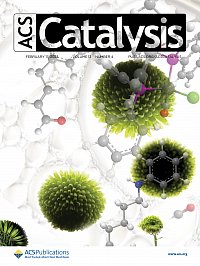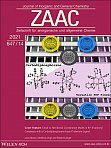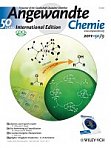Bücher/Kapitel/Cover
Covers

Frerk-Ulfert Wehmeyer and Robert Langer
A hampered oxidative addition of pre-coordinated pincer ligands can favour alternative pathways of activation; ChemComm 2023, 59, 40, 6004 - 6007. Inside Front Cover. DOI:10.1039/d3cc00874f
"Switching mechanistic pathways by micellar catalysis: a highly selective rhodium catalyst for the hydroamino-methylation of olefins with anilines in water“; F. Migliorini, E. Monciatti, G. Romagnoli, M. L. Parisi, J. Taubert, M. Vogt, R. Langer*, E. Petricci*, ACS Catal. 2023, 13, 4, 2702–2714.
https://doi.org/10.1021/acscatal.2c06104

Hydroaminomethylation (HAM) is a very straightforward reaction for amine synthesis usually performed in hard reaction conditions and using nonsustainable solvents. The use of micellar and microwave catalysis involves switching from the traditional HAM reaction mechanism to the efficient regioselective synthesis of linear amines. The cover is the result of a collaboration with artist Vanessa Rusci (https://www.vanessa-rusci-arte.com) in the context of a project for scientific dissemination. View the article.
https://pubs.acs.org/toc/accacs/13/4

Z. Anorg. Allg. Chem. 2021, 647, 14.
(https://doi.org/10.1002/zaac.202100151 )
The Cover Picture shows a series of rhenium(I) triscarbonyl complexes with a carbodiphosphorane-based tridentate ligand between two facades of the MLU Weinberg Campus. The [PCP] and [PC(H)P]+ coordination sides in the carbodiphosphorane ligand open a window to versatile coordination modes toward the ReI center. In this context the colored globes, highlighting the large impact of modern pincer chemistry, illustrate the meridional configuration of the carbodiphosphorane pincer-ligand in the reported rhenium complex to be located in the thermodynamic ground floor. Yet a facial arrangement was initially observed upon coordination to ReI, it is located in the upper floors of the building.

EurJIC, 2020, 41, 3884-3976, Front cover
https://chemistry-europe.onlinelibrary.wiley.com/doi/full/10.1002/ejic.202000950

Chem. Commun., 2017, 53, 7417 - 7417, Inside back cover
https://pubs.rsc.org/en/content/articlelanding/2017/cc/c7cc90262j#!divAbstract

Angew. Chem. Int. Ed. 2011, 50, 2120 –2124
Pages 1947-1947, Cover picture
https://onlinelibrary.wiley.com/doi/10.1002/anie.201100452
Buchkapitel
3. “Iron-Catalysed Homogeneous Hydrogenation Reactions“; T. Zell and R. Langer in Homogeneous Hydrogenation with Non-Precious Catalysts, Wiley VCH, 2019, ISBN 978-3-527-34439-0.
2. “Hydrogen Energy Recovery - Dehydrogenation“; J.-H. Choi, T. Zell, R. Langer and M. Prechtl in Energy Storage Handbook, Wiley VCH, 2019, ISBN 978-1-119-23935-2.
1. “Hydrogen Storage: Based on Hydrogenation and Dehydrogenation Reactions of Small Molecules“; T. Zell and R. Langer (Eds.), De Gruyter, 2018, ISBN 978-11-053642-3.

